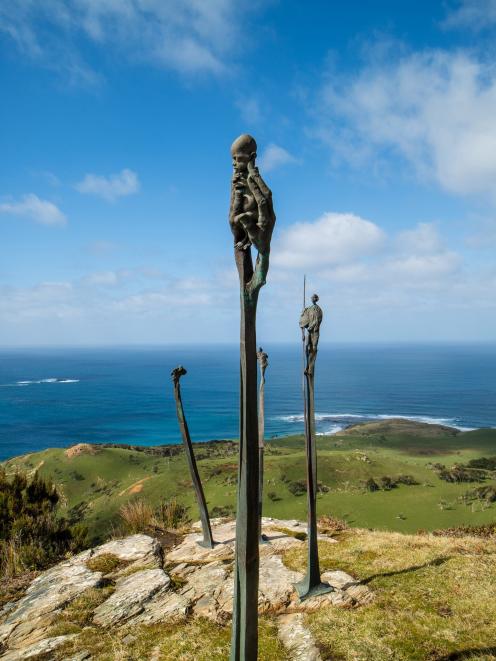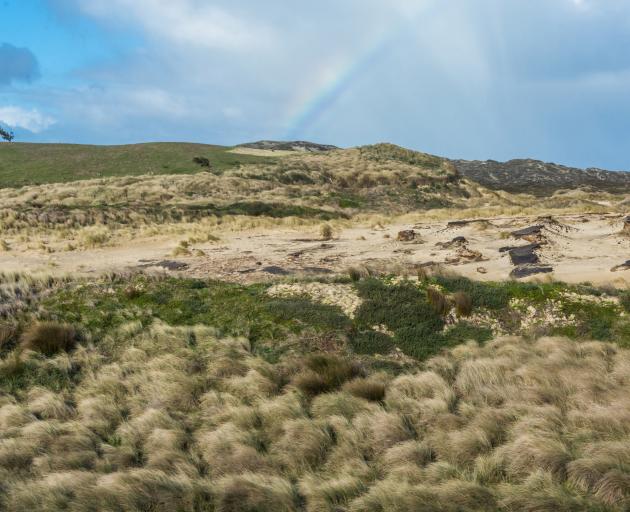Ewan McDonald runs through every reason why the Chathams should be on your 2022 travel hit list.
Here's a question that won’t turn up in the Kiwiana section at the Strangled Ferret pub quiz next week. What’s the one thing that all regions of Aotearoa are legally required to give their residents?
Clue: it’s not Three Waters or decent rubbish collection. It’s ‘‘an annual founding day during which workers can get the day off’’.
This act of generosity stretches to our farthest-flung council, even though it wasn’t included in the Treaty, didn’t become part of the motu umbrella for several years, and at one stage we were going to flick it to the Germans. Or the French.
This would be the Chatham Islands, 800km east of Wellington, aka Rekohu (‘‘Misty Sun’’) in Moriori, Wharekauri in Maori, and ‘‘the islands at the end of the weather forecast’’ in NewZild.
Remote, wild and utterly fascinating for the tri-culture, plants and wildlife, lifestyle and history, the 660 locals celebrate their anniversary day - in typically lo-fi style - on the Monday nearest to November 30.
That honours the day in 1791 when Lieutenant William Broughton ‘‘discovered’’ the archipelago, named it after his Royal Navy ship and claimed it for the British
Empire. He was about 300 years late.
Let’s not rabbit on about history. Let’s find a backpack of reasons why the Chathams should be on your 2022 must-do list. Tip: book flights, beds, tours well before you go.
Chatham Islands Museum
1 - First stop so you can understand why this place is so different from the mainland. The rest of the world, actually. There’s the natural history - rocks, fossils (including dinosaurs), rare birds and other wildlife. Then the culture, from its first people, the Moriori, to early European sealers, whalers, traders and missionaries, later Maori arrivals and still later European farmers. There are plans for a new museum more than six times the size of the present one, because there’s a lot of nature and history here.
The Moriori story
2 - This feature isn’t the place to recount the Moriori story and our education hierarchy’s shameful part in distorting it, but Kopinga marae is certainly the place to learn about the indigenous people and the vow of peace they were not prepared to break when invaded in 1835. Designed to recall the island’s basalt columns and flying albatross totem, this is the base for the revival of the language, cultural and community events. At Manukau, the statue of Tommy Solomon (Tame Horomona Rehe), the last known full-blooded Moriori who died aged 49 in 1933, stands as a memorial to all his people. At Te Whanga Lagoon (see 5) look for the nation’s earliest artworks, carved in limestone.
A Maori story
3 - Can’t be too many Kiwis who don’t know that ‘‘Wharekauri’’ translates as ‘‘kauri house’’. In the 1830s, some Maori living with Moriori built a house from kauri salvaged from the beach; within a few years that had become the Maori name for the islands. Ponga Whare is a relic of the Chathams’ days as New Zealand’s penal colony (see, it wasn’t just the Aussies). The Government transported 250 Maori prisoners, their wives and children, including Te Kooti, the Ringatu prophet, guerrilla fighter and alleged spy. They built a fort, houses, roads and took up farm work, building the whare for their employer and his family before rebelling and commandeering a ship to the mainland. At the beach, see Taniwha or Splatter Rock’s 5-million-year-old, star-shaped lava formations; oystercatchers and other rare seabirds nest here.
... and a German one
4 - Who knew? German missionaries lobbed up in 1843. It wasn’t the most successful evangelical outing of all time - they didn’t convert a single local. However, they introduced large-scale horticulture, sheep farming, shipbuilding and reading ’n’ writing, and built Maunganui Stone Cottage in 1866-68. Fervent lifestylers, they DIYed the building from local stone, pipi-shell mortar and akeake timber, surrounded it with fruit and vege gardens, a woolshed and stables, and drained swamps for farmland. Relations with Germany were not so cordial in 1940: its navy boarded and sank the islands’ floating Countdown, the supply ship Holmwood, capturing the crew and local passengers.
Forget-me-not
5- Plants. Seabirds. Marine mammals. You’ll be blown away by the presence of so much, and so visible, nature on show. The islands are home to about 50 plants adapted to the cold and wind, such as Chatham Islands forget-me-not, rautini, kakaha and akeake or tree daisy; a breeding ground for huge flocks of sea and land birds - the magenta petrel, black robin and Chathams oystercatcher, pigeon, parakeet, snipe, shag, shore plover and gerygone (I’d fly two hours to see something called a gerygone). Floating around are sea lions, leopard seals, southern elephant seals and many species of whale. Immerse yourself at Awatotara Bush Coastal Track, hiking native bush teeming with birdlife to the rugged coast. The three-hour walk takes in Taiko Camp and Gap Sanctuary. Nikau Bush Conservation Area at Te Whanga Lagoon is a 45-minute ramble through 19ha of forest glades to the towering palms, once common here. Admiral Garden, 20km from Waitangi, attracts birds, bees and butterflies; humans will appreciate the garden and nearby Te Hau Kohaki wetland and Ngatere coastal bush reserves.
On the rocks
6 - Seriously ancient history - like, even older than glass milk bottles and dial telephones. The Basalt Columns at Ohira Bay are a relic of lava flows from volcanoes that erupted about 80 million years ago. There weren’t any humans around to see it but dinosaurs would have enjoyed the show. While they look as though they were stamped out of some factory - they’re geometrically perfect hexagonal columns - the formations were created naturally as hot lava met cold water.
Hunting, fishing and eating
7 - Rod and gun country. These remote islands surrounded by cold, clear water are world-famous for year-round sea fishing: blue cod, hapuku, kingfish, terakihi, blue moki and shark if your taste runs to things with fins; crayfish, paua, kina if you prefer shells or exoskeletons. Hunters aim for pigs and more exotic quarry: wild sheep, which have roamed Pitt Island for 150 years, and nibble away on isolated rocky cliffs. For those who stalk their game on shelves, Chatham Island Food Co in Waitangi specialises in fresh, frozen and live seafood. Honey from the unique flora is sensational: Go Wild apiaries has the world’s last Black British bees and imported Italian breeds, and produces a special freeze-dried range.
Arts and crafts
8 - As might be expected, the unique culture, environment and lifestyle are an inspiration to artists. At Studio 440S, Moriori and Maori legends and traditions are expressed through paua mosaics, acrylics on canvas and treasures crafted from the Chathams’ natural resources. In her Kahukura Studio in Admiral Gardens, Lois Croon creates paintings, jewellery and her signature forget-me-not ceramics while Eva-Cherie Artz reimagines her surroundings and environment at her Owenga studio. Photographer Celine Gregory-Hunt has created a range of island-inspired merchandise, while Celestine Lanauze’s canvas and ceramic works, and clothing, are part of the range at Chatham Cottage Gifts, Waitangi.
East side story
9 - Home to about 38 people, Pitt Island is the only other inhabited island in these parts. There’s a school (most older kids board on the mainland), wharf, church, grass landing strip and a lodge. Most homes have satellite TV and broadband but each household has to generate its own power (generator or wind turbine). A supply ship visits every few weeks and the whole island turns out to unload it. Why take the 20-minute flight or 50-minute boat ride? For the pristine environment on land and water, the spectacular scenery of rolling farmland, wild coastlines and bush-cloaked hills and valleys. Bird and plant life - the birds are more numerous than on Chatham; fishing, diving and drawing a bead on those pigs and wild sheep. Historic places: Glory Cottage, a shepherds’ hut built of kauri in the early 1860s. It’s a superb example of carpentry: virtually no nails were harmed in the making of this building; and Flowerpot Bay Lodge, the 1843 Hunt family homestead, which descendants operate as the island’s only accommodation.
Another pub quiz question
10 - What’s the first place in the world to greet the new day? If you answered Maunga Hikurangi, go up to the bar and get the next round in. Mt Hakepa on Pitt Island is recognised as the first inhabited place where dawn breaks. Climb it and take in 360deg views of the archipelago and ocean, appreciate the bronze sculptures placed to welcome the millennium, and tell yourself: ‘‘I was the first person in the world to see the sun today.’’
Need to know
• The Chathams are about 800km east of Wellington. Chatham is the largest island, Waitangi (population 200) the largest town.
• Air Chathams operates flights from Auckland, Wellington and Christchurch to Tuuta airport (2 hours, give or take). It also flies to Pitt Island (20 minutes, advance bookings essential).
• Chathams time is 45 minutes ahead of the mainland; there is no cellphone coverage or taxi. Accommodation is limited; no camping or freedom camping.
More info
















